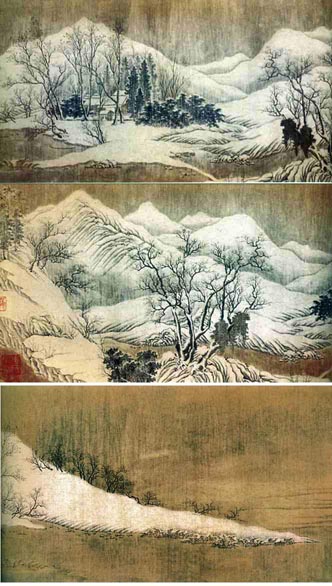 |
|
| Ink and Wash Painting |
| CCTV.COM 2003-06-13 21:06:25 |
|
 Ink and wash painting is a genre of traditional Chinese painting done on xuan paper in black using no other colors. It is simple yet elegant. It gradually became the most important style of Chinese painting in the Yuan Dynasty during the 13th century. Ink and wash painting is a genre of traditional Chinese painting done on xuan paper in black using no other colors. It is simple yet elegant. It gradually became the most important style of Chinese painting in the Yuan Dynasty during the 13th century.
Ink and wash paintings are executed with the Chinese writing brush. The oldest ink and wash paintings discovered in China are those painted on potteries dating back to prehistoric times.
Chinese painting and calligraphy are closely related. They are considered as arts originating from the same source.
“Chinese painting and calligraphy are closely related to each other. They came from the same source. This theory was advanced by Wang Wei, a great poet and painter in the Tang Dynasty,” said Professor Zhang Ding from School of Fine Arts of Tsinghua University.
Ink and wash painting was still in its embryonic stage during the Tang Dynasty, which existed from 618 to 907. The ink and wash landscape style is attributed to Wang Wei and an another Tang master painter Li Sixun. Wu Daozi, a great name in figure painting in the Tang period, developed a unique style of brushwork used in portraying the contours, folds, or wrinkles of garments. His style of brushwork was widely used by successive generations of figure painters.
The pottery jar discovered in the tomb of Crown Prince Li Hong of the Tang Dynasty in Luoyang, Henan Province features hills, streams, rocks, and pine trees painted in ink and wash. Dating back to 1,200 years, it is the oldest existing ink and wash painting in China.
During the Song Dynasty, which was found in the 10th century, a new type of painting came into being. Known as literati or scholars' painting, this type of painting stressed the creative use of ink and wash without bright colors. Its subject matter consisted mostly of plants and flowers, as well as deserted or distant mountains and streams.
During the Ming and Qing dynasties, which existed from the 14th to the early 20th centuries, ink and wash painting became one of the principal genres of Chinese painting with simplicity and elegance as its attractive characteristics.
“Chinese painting is different from that of the West. Western artists stress likeness to reality in painting. But their Chinese counterparts wish to portray their impressions of reality. Chinese painting is closely related, in spirit and technique, to Chinese painting. The Tang master painter Wang Wei stressed the use of black ink in painting. China is a land of plenty. It invented paper and the writing brush. The earliest Chinese paintings were all done in ink and wash,” said Professor Zhang Ding.
Ink and wash paintings are mostly done in black and white. Ancient Chinese painters were skilled in using various tints of black to present their objects, they classified the various tints of black into five groups, namely, the dark black, light black, black, dry black, and wet black.
In addition, they often left a sizable space unpainted in their works in order to make their compositions more lucid and lively.
Ink and wash painting is part of Chinese cultural heritage. Today, it is received and appreciated by an increasing number of art lovers in the world.
|
|
Editor: Liu Baoyin CCTV.com
|
|
|
|
|
|
 |









